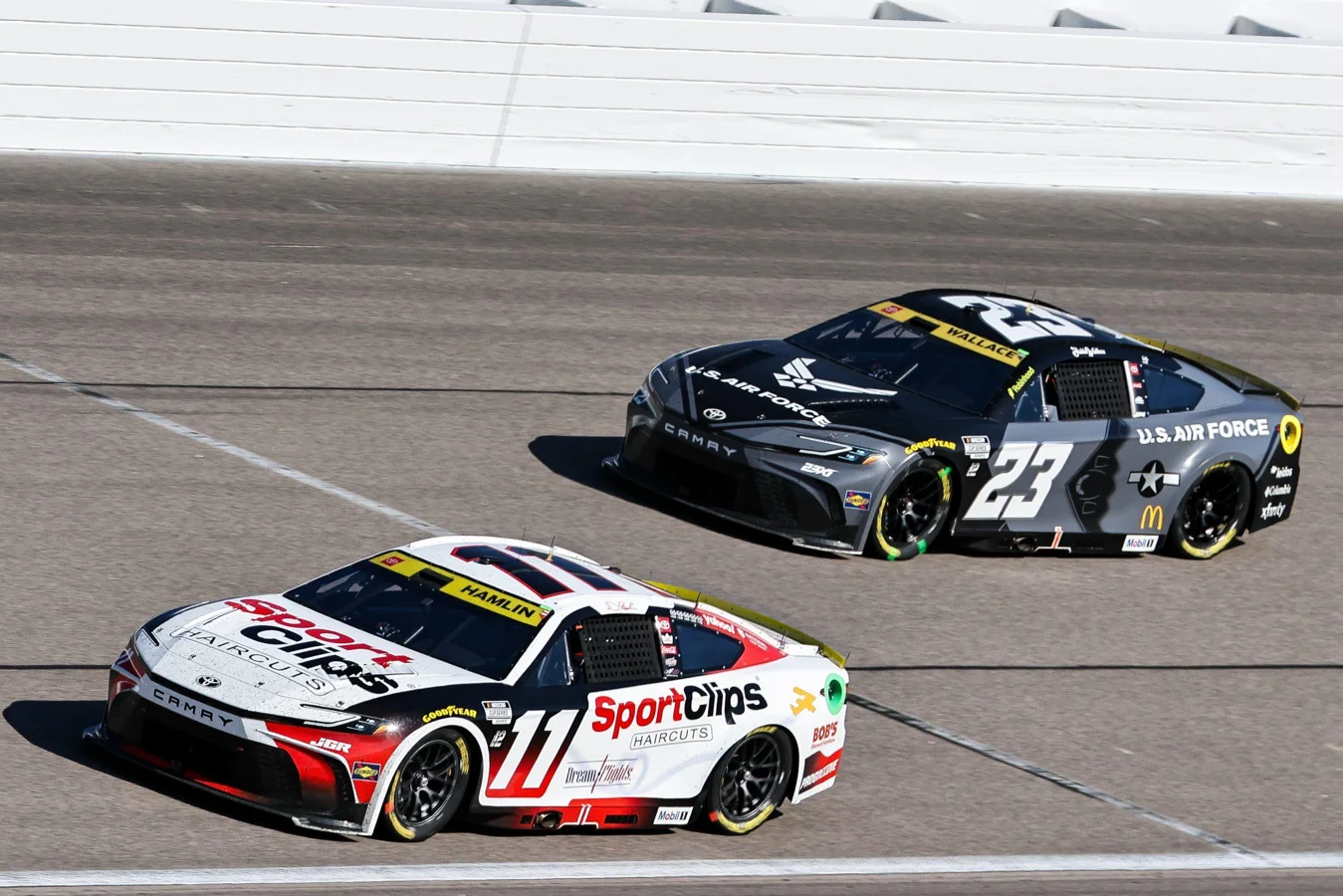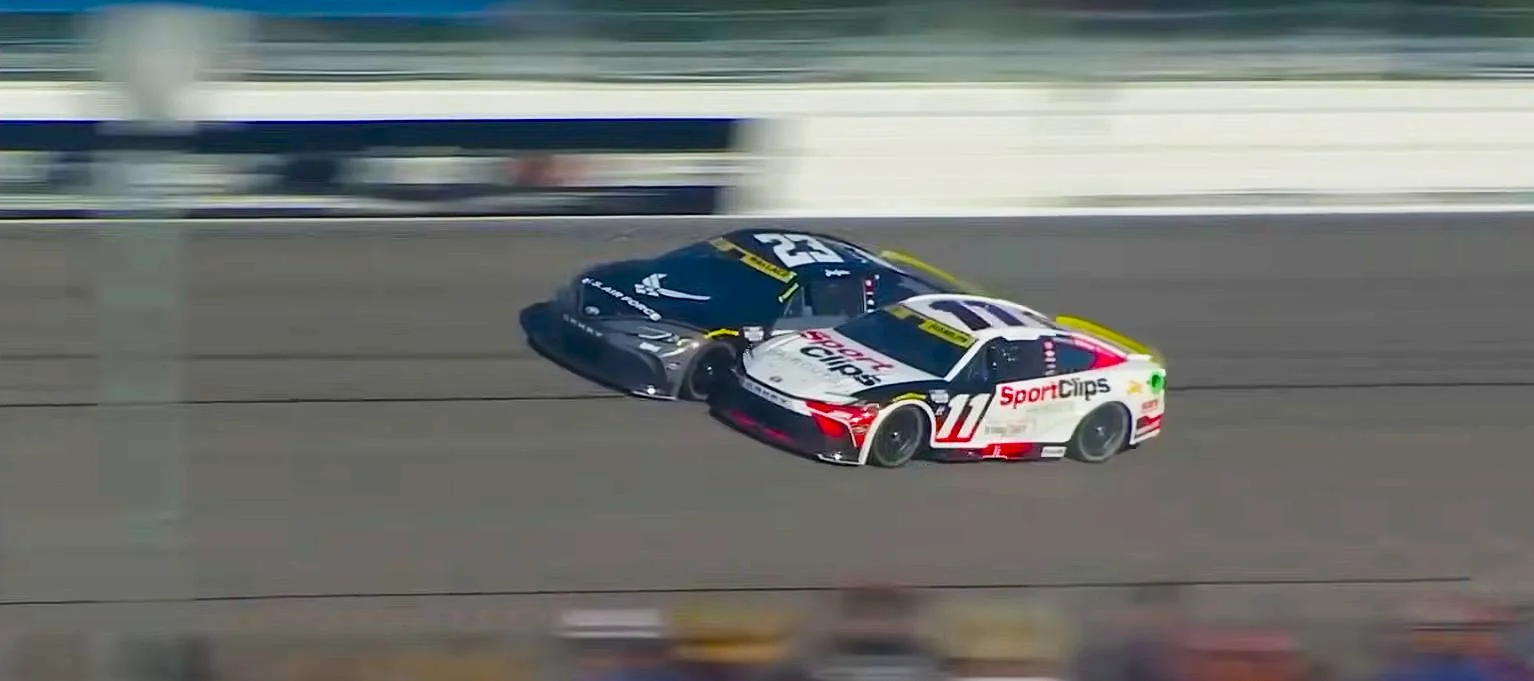Tensions have risen after the recent Denny Hamlin Kansas incident during the R-12 race, with 23XI Racing driver Bubba Wallace feeling betrayed following a late-race collision involving his team co-owner. The incident has sparked controversy and strained the relationship between Hamlin and Wallace as the NASCAR playoffs intensify.
Hamlin Faces Criticism Following Clash With Wallace
Denny Hamlin, a seasoned driver for Joe Gibbs Racing, is under scrutiny for the second race in a row after his actions at Kansas, where he sent Bubba Wallace, who races for his own 23XI Racing team, into the wall with half a lap left. This follows an earlier incident at New Hampshire in which Hamlin spun out his teammate, Ty Gibbs. These back-to-back disputes have put Hamlin’s on-track decision-making and team dynamics in the spotlight.
The Denny Hamlin Kansas incident came at a crucial point in the race and left Wallace frustrated, raising questions about Hamlin’s approach given their unique employee-employer relationship. Hamlin used his Actions Detrimental podcast to clarify his perspective, noting that emotions ran high due to unfulfilled expectations with both Gibbs previously and now with Wallace.
I think that’s where feelings can get hurt is when you have expectations, and those expectations aren’t met. It’s why I lost my temper last weekend. I had an expectation. I thought we knew that if you’re in the playoffs vs. out, the rules are different.
Denny Hamlin said via Actions Detrimental.
Hamlin discussed that in the pressure of NASCAR playoffs, he expects certain unwritten rules to be honored, especially between playoff contenders and those not in contention. The unfulfilled anticipation was also central in his altercation with Wallace, who, Hamlin acknowledges, might have expected more leniency from his boss on the track.

The actions didn’t meet my expectations, so then I got hot. And so, I think sure, if you think that I owe you this or that, your feelings are probably hurt today.
Denny Hamlin added.
This acknowledgment highlights the complexity when racing dynamics overlap with employer-employee roles. The collision has redefined the relationship between the two; Hamlin can no longer anticipate that Wallace will prioritize their professional bond over competitive instincts in future races.
Examining the On-Track Decision and Hamlin’s Regret
Reflecting on the event via his podcast, Hamlin admitted that his split-second judgment during the final lap was influenced by the pressure of the race and mechanical issues, including problems with his power steering. The veteran racer stressed how quickly decisions must be made in such moments and recognized that his choice impacted not only his own race but the broader team and playoff standings.
I have about a second to analyze this as I’m going down the backstretch. As a driver, what I’m trying to do is figure out angles. What angle am I going to take this corner, where is the guy beside me — all those things play a factor in how deep you can drive into a corner or how shallow you need to be or whatever.
Denny Hamlin said.
The high-speed environment allows only a brief moment for calculations about positioning and angles. Hamlin, a three-time Daytona 500 winner, admitted that he was not fully aware of how close Wallace’s No. 23 toyota/”>Toyota was to him at the time, partially due to possible lapses in communication with his spotter.
So, now that I can analyze this more out of the car and look at this more, again, while I’m in this car, in this cocoon going into Turn 3, I don’t even see the 23. I don’t know how close he is, I don’t know if he’s a car width up, is he right on my door. Those are all factors in how your car is going to take the next corner. And so, there are things I would do differently, no doubt about it.
Denny Hamlin added.
In hindsight, Hamlin conceded that he would have managed that high-pressure situation differently, particularly given the razor-thin margin between the vehicles as they approached the corner. The lack of clear information about Wallace’s position played a key role in the contact, which ultimately changed the race’s trajectory.
The Fallout for Playoff Dynamics and Teams
The aftermath of the Denny Hamlin Kansas incident has reverberated through the garage, further complicating playoff strategies and team alliances. Wallace’s disappointment is heightened by the expectation that, as his boss, Hamlin might treat him differently from other competitors. Yet, the on-track battle ultimately benefited Hendrick Motorsports, with Chase Elliott capitalizing on the disruption and overtaking four Toyotas for the win. The move not only damaged momentum for Hamlin and fellow Toyota driver Christopher Bell but also allowed Chevy to secure a critical victory.
The evolving landscape of NASCAR’s playoffs means that, moving forward, personal relationships may play less of a role as racing instincts take over. Wallace, feeling aggrieved by someone he trusted, is unlikely to offer quarter should their rivalry reignite in a future event. For Hamlin and his Toyota colleagues at Joe Gibbs Racing and 23XI Racing, the pressure is now greater as they reevaluate communication and on-track decision-making entering the next playoff round.
This latest dispute at Kansas marks another dramatic chapter in an already turbulent playoff season, further intensifying the emotional and strategic stakes for every racer and team pushing for the championship.

